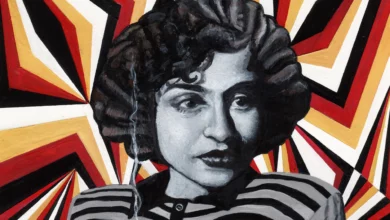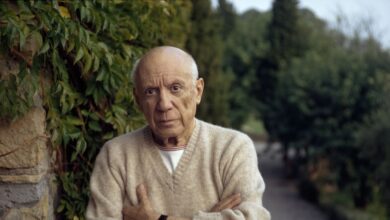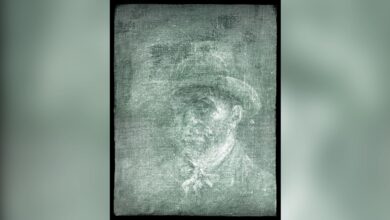
Ahmed Kassim handles paint confidently. He uses it in a relaxed way. He paints silhouettes and fills them in cursorily with thick paint. He drags paint quickly and thinly from one black outline to another to create forms.
“Chaotic Order” is the second solo show the 28-year-old artist has had at Safarkhan Gallery. The first was in 2011. This time, there are 10 large-format paintings.
Each painting is busy with traffic, buildings, figures and symbols, filling the canvas to its edges, in the tradition of history paintings or murals, like the ambitious figuration of graduates of the Leipzig Art Academy.
There is a very obvious political message in almost all of Kassim’s works, which are always slightly too vague to be illustrations for newspaper editorials. They have no titles and do not narrate specific events; each is a different amalgamation of similar elements.
The repeated use of aerial views of rundown urban environments gives a familiar, breaking-news feel. The city is always toy-like, suggesting video games or Lego. The humor is sarcastic.
There are deformed creatures wearing beards or niqabs, or cyborg-beings that are half-human, half-car, like the typewriter-insect in David Cronenburg’s hallucinogenic, drug-addled film “Naked Lunch.” A triptych of three big-bellied car-humans sitting on thrones, which are in turn placed on prayer mats, apparently resemble different factions in Egypt.
One is a Christian leader in a pope-like costume, another an Islamist with a beard and bared teeth, and the third a man in a suit with a Mercedes symbol that seems to be the liberal or secular current.
In another painting, two car figures sit on a green sofa and hold joysticks next to a stack of crudely painted video games with titles such as “Democracy Game” and “Betrayal Game.” Cars and buildings emerge out of the pattern on the carpet.
In one of the first paintings you see when you enter the gallery, large red and black bats take up the foreground, flying or hanging on painted black strings. In the background beneath them, a giant, scantily clad woman lies in between or on top of buildings and cars, her bottom facing the viewer. One bat holds a sign saying “Islamiya, Islamiya.”
It is pretty easy to identify the artist’s view of the political scene in Egypt right now.
A dark painting of ghostly, rather apocalyptic buildings with people in army uniform on top weeing long bright yellow curvy lines onto the gray city below is an obvious echo of a notorious photograph of a soldier urinating on demonstrators during clashes near the Cabinet building in late 2011.
Another mixture of fantasy elements with references to real events can be seen in a panoramic view of a construction site in Moqattam, where the Muslim Brotherhood headquarters is located. Kassim has added an imaginary rocket launch pad, reminiscent of the Renaissance Project, the Brotherhood’s promise to the people of Egypt before the presidential elections.
It also brings to mind the time President Mohamed Morsy claimed to have spent working for NASA and the fact that he denied it afterward.
There are all sorts of symbols scattered around this painting, strong references to specific events, trends and even people. A truck full of dead animals in one corner may evoke the pig slaughter frenzy in the clumsy war on pig flu in 2010. The clown standing on a little throne surrounded by bodyguards is definitely suggestive of Morsy.
In another painting, a game of snakes and ladders takes place on tight ropes high above a map of Tahrir Square and its environs. Familiar stereotypes perch alongside playing cats. Who will reach the top first?
“HONOUR” is spelled out in a corner of the painting. “I’M THE ONLY WINNER,” it says near a policeman on a scooter.
The fun of translating visual elements is exhausted after a while. And the boyishness of the strangely sinister, half-human motifs — absurd and creepy creatures — is pretty familiar. Kassim’s nonchalant painterly style, his deliberately accidental brushstrokes, are the most expressive element about the chaos.
Otherwise, the show is a bit like a broken record, saying the same joke over and over, stuffing every corner with symbols in case there is any doubt. The paintings are spacious, but they do not give much space to viewers to think for themselves.
This piece was originally published in Egypt Independent's weekly print edition.





